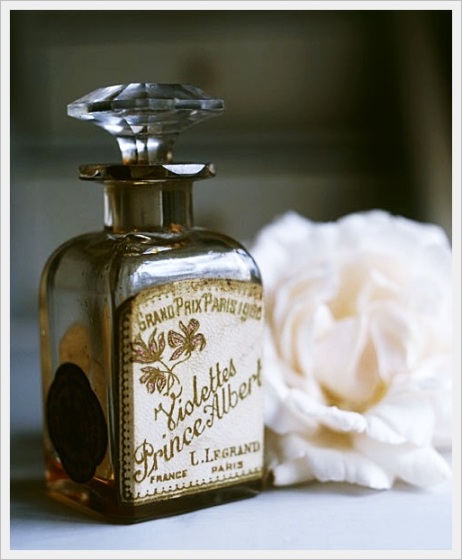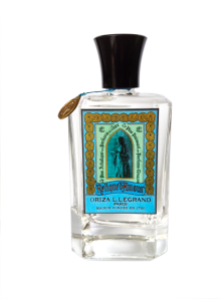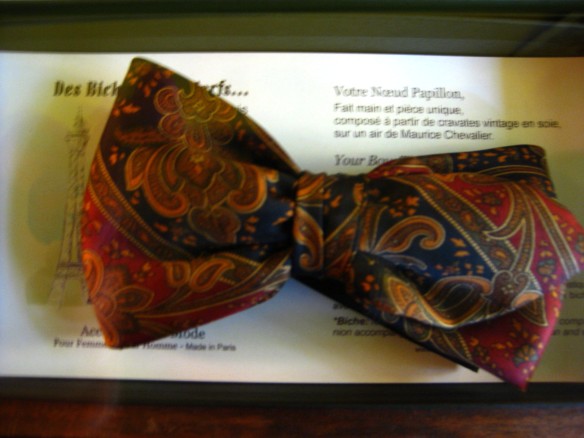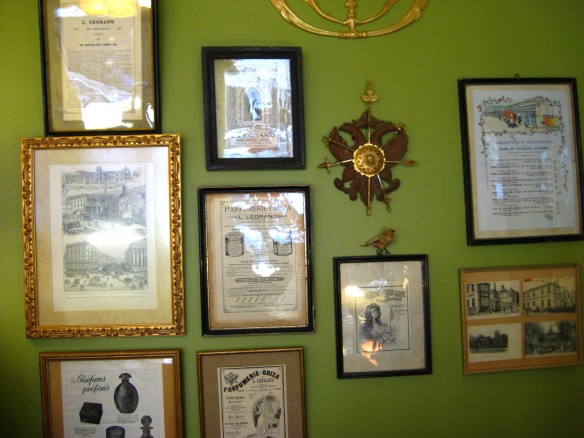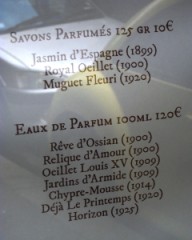Yesterday, we looked at three fragrances from Oriza L. Legrand, starting with their mossy masterpiece, Chypre Mousse. Today, I thought we’d take a look at some of their more traditional floral scents. I should confess at the outset that pure florals aren’t generally my preferred fragrance group, so I responded much less to these than to Oriza L. Legrand chypre and orientals. However, they’re all very well done, with elegance and sophistication, and they have that unusual Oriza character that makes all the fragrances stand out as something very different from the rest of the things currently on the market.
RELIQUE D’AMOUR:

The fragrance of an old chapel of a Cistercian abbey. Cold stone walls covered with damp moss. Waxed wood of the altar and old pews ornate with carvings. Linseed oil in lamps. Air smelling of incense and myrrh. But how fresh and spicy the smell of white royal lilies on this background! Subtle floral scent with green accents of leaves and powdery touches of yellow pollen. The beam of light breaks through the stained glass and illuminates this olfactory tumult of feelings varying from exaltation to humility and back. The silence which creates a sense of the divine call.
Top notes: Fresh Herbs, Pine.
Middle notes: Powdery Notes, White Lily, Pepper, Oak, Incense, Myrrh, Elemi.
Base notes: Musk, Moss, Waxed Wood, Woody Notes, Pepper.

The Relique d’Amour. Source: Oriza L. Legrand website.
I’ve changed my mind on the accuracy of Oriza’s description for Relique d’Amour, a fragrance that, for me, is really a lily scent first and foremost. I now think there is quite a bit of truth to the backstory, especially that ray of light illuminating the white flowers. I’ve also changed my order of favorites for the Oriza Legrand fragrances, moving Relique d’Amour up to third place in lieu of Reve d’Ossian. The simple reason is that Relique d’Amour has the oddest, and most Lutens-like, twist on white lilies, and I find it fascinating.
In a nutshell, if Serge Lutens took an enormous armful of white lilies to an old, dusty French church, accidentally dropped them along with a bottle of black pepper, and got on his knees on the waxed wooden floor to pick them all up, he would probably have been inspired to make Relique d’Amour, a completely different take on an Avignon church scent.

Source: .fotopedia.com
My mental categorization of Relique d’Amour as a “lily” scent means that I’m consistently and continuously startled by its opening, to the point that I have to sometimes pick up the vial to ensure I haven’t sprayed on the wrong perfume. I’m not a fan of the opening, but then I’m not a huge fan in general of olibanum, white incense fragrances with their dusty, aloof, very High Church feel. And the opening 5 minutes of Relique d’Amour are tough for me. It begins with a veritable explosion of black pepper that is so intense, you could sneeze. On its heels, other notes soon follow: herbs, freshly crushed pine needles, floral powder, and something almost aldehydic.

The Gegherd Monastery. Source: tripadvisor.com
The troop’s rear guard is quickly brought up by a tidal wave of dust and white incense, in a combination that feels very similar to the early notes in Reve d’Ossian. It’s the olibanum-opoponax duo of myrrh cousins, infused with the dust of ages in a very old monastery filled with parchment scrolls. Black pepper is sprinkled all over the top of this ancient, olfactory tapestry, while underneath lurks the slow start of something floral. Oriza L. Legrand is completely accurate in describing the overall combination in those early moments as “the smell of an old chapel of Cistercian abbey.”

Source: picturenation.co.uk
Thankfully, it’s a very brief thing. Five minutes into that sharp, difficult start, Relique d’Amour changes. It’s as if a ray of light beamed through the heavy particles of dust in the old monastry, shining a tunnel of white on a single vase filled with while lilies. It stands in the corner, its stamen heavy with yellow pollen, and the beam of light releases its sweet fragrance into the air. Suddenly, a wave of sweet, dewy, pollen-laden white lilies rolls over the intense cocktail of black pepper, dust motes, and dry, cold, white, slightly soapy High Church incense.
Relique d’Amour is suddenly transformed into something very different, centered on a dewy, sometimes dry, sometimes metallic, lily infused with incense. To me, it’s unusual the way the traditionally indolent white flowers have had their syrupy sweetness and narcotic opulence dried out by cold incense. There is more to the scent and flowers than that, however. There is a also drop of what feels like honey (undoubtedly from the wax element), alongside sweetened woods and a touch of floral powder. Lurking underneath are flickers of bright, fresh grassiness, evocative of summer and contrasting sharply with the feel of very old wood that has been cleaned with a gentle film of soap before being waxed to a high shine. It’s an odd mix but it is also oddly appealing, though it takes a few tries to get used to it.

Close-up of the pollen on a lily’s stamen. Source: drgulyas.hu
The combination of lilies blended with dust, sweet pollen, old wood, slightly honeyed, waxed wood, and undertones of soapiness feels like a complex set of contradictions. That’s probably why I repeatedly think that Relique d’Amour is the sort of startling paradox that Serge Lutens would do. The difference is that this twisted lily feels very old in nature, though that is probably a result of the dust and myrrh combination. Then again, Bertrand Duchaufour used that to great success in his (overly praised) Dzonghka, so perhaps Relique d’Amour isn’t actually so dated after all.
Relique d’Amour’s sillage starts off as moderate, then turns soft. The fragrance is airy in weight, but initially potent and strong when smelled up close. Like a number of the Oriza fragrances, the sillage is far too intimate, polite, and low for my personal tastes. It also doesn’t last forever on my wonky, perfume-consuming skin. At the start of the second hour, Relique d’Amour hovers a bare inch above the skin, as soft as a nun’s white veil. It’s a bouquet of lilies infused by white church incense, the thinnest veneer of floral soap, green grass, and sweet pollen. An hour later, it’s a skin scent that is a blur of lily and sweet pollen. All in all, Relique d’Amour lasted around 6.5 hours on me with 2 small sprays, and just barely over 7.75 with 4 large squirts. Something about all the Oriza L. Legrand perfumes — with the exception of the outstanding Chypre Mousse — doesn’t seem to work well with my personal skin chemistry. Others, however, seem to have much better luck, with a few consistently averaging between 10-12 hours from the same scents.

Source: wallpapermay.com
Mark Behnke of CaFleureBon tried four of Oriza’s floral fragrances at the start of the year, and Relique d’Amour was his favorite. (He concedes that they all have average longevity. In my opinion, Mr. Behnke’s skin normally retains scent like glue, at least as compared to my own, so I think that his estimate says something.) I largely agree with his review of Relique d’Amour which reads:
Relique d’Amour is my favorite of these first four releases but I think this will probably not be the most popular. My reasoning is that Relique d’Amour is that rare fragrance which seeks to paint a picture with olfactory notes. There is less of a pyramid in place and more of a sense of a specific place. I love poking around in old stone churches. When I have the opportunity to do this the smell of the stones covered in moss and the aged wood of the supporting timbers is a singular smell to me. Relique d’Amour is that moment of standing in an old abbey surrounded by the layers of residue from the oil lamps and censers. As I said Relique d’Amour really paints a singular picture and doesn’t really devlop so much as rise fully formed off of my skin. There is the raw pine of the timbers, a strong stony mineral aspect, a bit of lily, wisps of myrrh, elemi, and frankincense. All together they impart a weight of history and place upon Relique d’Amour and it is a place and time I want to visit often.
I don’t agree that Relique d’Amour would be the most difficult Oriza Legrand fragrance for people to like. (That would be Jardins d’Armide, in my opinion, but he didn’t test that one.) People actually seem to like Relique d’Amour a lot. For one thing, it is the fragrance that the famous beauty and French actress, Isabella Adjani, fell in love with and bought for herself. For another, there is enormous enthusiasm for the fragrance in the early comments on Fragrantica. One commentator who tested the perfume wrote:
The very first sniff is green, a freshly cut evergreen, not piney, not at all pine disinfectant-esque, second scent is a dusty old book, bookmarked with a love letter, left in an old church, it’s beautiful, incredibly atmospheric. You can see the daylight filtering through dust motes onto pews. It’s maybe not something you would wear on a first date, it is not the type of fragrance just anyone will understand. If you appreciate fragrance as an art form and not something you just splash on day after day, just because, then you may love to smell this for the pictures you will get from it.
The lilies come into the forefront soon after, enhancing the very church-y feel, but not sharp, as lilies can be, these are dominant but soft.
ETA, I reviewed before reading the description above, deliberately. I realise now after reading it looks like I just copied it! It is incredibly evocative and clearly does what the perfumer intended!
There are many similar descriptions of Relique d’Amour, all positive. I think the reviewer above is completely right in finding the fragrance to be more like an evocative mood than something easy that you can easily just spray on before you go to the supermarket. It’s not an every day perfume. It is not even the most approachable perfume. It is, however, very Serge Lutens-like in its twists and turns. I think it’s very original, and stands out a mile away.
OEILLET LOUIS XV:
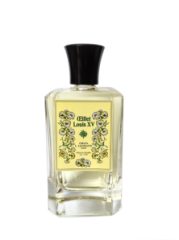
Oeillet Louis XV.
Oriza L. Legrand’s roots go back to 1720 with the patronage and admiration of King Louis XV. So, in 1900, the house paid him homage with a carnation scent called Oeillet Louis XV. (The word for “carnation” in French is oeillet.)
Powdery and peppery, silky and spicy, Oeillet Louis XV soothes yet confuses with its paradoxes. Reminiscences of an ancient time, powder fades and gives way to spicy notes of clove. […]
White carnation is at the heart of this fragrance and is the source of its dichotomy. Symbol of true love under the monarchy, the flower embodied the fire of French Revolution. As a scent, white carnation is as intoxicating as the most subtle poison; a delicate blend of mandarin, monarchical iris and light wood chords, which cannot resist the violence of pepper and spicy clove. Pink carnation brings a note of bitterness, symbol of Mary’s sorrow. Legend has it the flower sprang where Mary’s tears fell as she saw Jesus carry the cross. […]
Top notes: Pink Pepper, Mandarin.
Heart notes: White Carnation, Carnation Absolute, White Orchid, Iris, Rose, Spicy Clove.
Base notes: Rice Powder, White Musk, White Honey, Woody Notes.

Source: Walltor.com
Oeillet Louis XV opens with sharpness. Great sharpness that feels as cold as ice. Like a blade that cuts through you, the fragrance bursts with the pungent, peppered, spicy, and metallic coolness of carnation. It seems simple and limited, perhaps deceptively so. The peppered carnation is infused with dewy floral elements, a light touch of powdered iris, and a damp greenness like young shoots. Something, somewhere feels like the tender sweetness of violets. Underneath the sharpness of the carnation and the bite of pepper, there is the subtle spiciness of cloves and the bitter sweetness of a neroli-like orange.
It all feels as cutting as a sharp crystal but, at the same time, there are glimpses of a spicy orange-brown, a peppered black, a tender violet, a powdery rose, and vistas of fresh, clean, crisp, grassy green. Soon, the iciness is softened and tamed by the floral powder which I think smells dated and old-fashioned. Actually, I find it to be a strange contrast with the pungency of the carnation, bitter cloves, spiced orange, and pepper. It pains me a little, but then my threshold tolerance for powder in perfumery is very low.
On my skin, Oeillet Louis XV doesn’t get much more complicated than that. In fact, from a distance, it eventually turns into something that is merely a cloud of carnation. Like many of the other Oriza L. Legrand florals, Oeillet Louis XV has weak longevity and average sillage on my skin. The fragrance is initially very potent up close, but there is only an small cloud around me, maybe about 3 inches. It soon turns soft and weak on my neurotic skin, a blur of carnation with a touch of floral (iris?) powder. It’s all very hazy, and fades away after 6.5 hours. As I’ve mentioned, my skin is not the norm. On Oeillet Louis XV’s Fragrantica page, the two votes thus far for longevity are split between “long lasting” and “very long lasting.” Sillage is put at “moderate” and “heavy,” though Mark Behnke found that Oeillet Louis XV … has sillage to burn.”
Mr. Behnke had a very different experience with Oeillet Louis XV than I did. Frankly, it sounds rather terrible to me, a plethora of powder that I’m glad I was spared. In his review, he wrote how it felt something suited to Madame de Pompadour, the King’s favorite mistress:
… Oeillet Louis XV is a very powdery focused fragrance and it feels in keeping with the famous hairstyle which bears her name as the powder keeps rising and rising until it is neatly arranged around clove and musk. Oeillet Louis XV begins with a double dose of carnation and then adds iris and rose. If you still don’t have enough powdery facets a heaping dose of rice powder is added. I’m not the biggest fan of powdery fragrances and I have to admit the early exuberance always took me right to the edge of my personal tolerance. Just as I thought it was too much the clove cleaved through all of the powder along with a sheer white musk and the powdery façade was laid bare. Now these two notes carry the development and the final stage is coated in a light bit of honey and balsam. If you love powdery fragrances Oeillet Louis XV should be on the top of your list to sample.
The only comment on Fragrantica for Oeillet Louis XV seems to convey an experience a wee bit closer to my own:
The carnation is treated here in the purest transparency and purest nature. The flower is like windswept, through the wild grasses, with large gray clouds in the sky. Really beautiful.
The most detailed assessment I’ve seen for Oeillet Louis XV thus far comes from a commentator on Parfumo, “Drseid,” who seems to have had the best experience of all of us:
Oeillet Louis XV opens with a fruity orange and dewy rose tandem with a slight carnation undertone. As the fragrance enters the early heart the orange dissipates as the carnation takes the fore, building in intensity with the rose hanging around in the background bolstered by traces of additional clove spice and powdery iris support. As the composition reaches the late dry-down the slightly powdery iris dies but the now diminished carnation remains, joining prominent white musk with a vague natural woody undertone fading in and out through the end. Projection is average and longevity is very good at 9-11 hours on skin.
[…] The late dry-down is quite pleasant with the fragrance turning slightly sweet and just a tad woody, though the woods are quite subtle and at times elusive. The bottom line is the 120 euro per 100ml Oeillet Louis XV represents a mostly successful spiced carnation and rose presentation with just a touch of powder in the heart and a skillfully executed gentle light woody musk finish, earning a “very good” rating of 3.5 stars out of 5. Fans of fragrances like JHL by Aramis in particular will most likely enjoy this. [Emphasis in font to names added by me.]
I see very different perfume comparisons for Oeillet Louis XV. Something about its cold, cutting opening calls to mind the passing sniff I gave to Serge Lutens‘ icy carnation scent, Vitriol d’Oeillet which Fragrantica says has some similar notes in common: nutmeg, clove, pink pepper, pepper, paprika, carnation, wallflower, lily and ylang-ylang. For most people on Fragrantica, the Lutens fragrance is mostly a bouquet of carnation, pepper, and cloves, and Oeillet Louis XV can be that, too. The real similarity to me is in the iciness, the sharp coolness of the flower. Oeillet Louis XV, however, has significantly more powder, along with iris, rose and orange at its base, and subtle hints of some mysterious, grassy greenness that I can’t explain. For some inexplicable reason, for me, Vitriol d’Oeillet actually has the feel of some very old, vintage Guerlains in its floral powderiness, but without the latter’s Tonka vanillic signature and rounded warmth. As a whole, I think Oeillet Louis XV is well done, but it’s far from my personal tastes.
JARDINS D’ARMIDE:

Oriza L. Legrand says that Jardins d’Armide is a floral tribute to legendary gardens. Their description reads, in part, as follows:
Les Jardins d’Armide was the symbol of beauty, lush and beautiful, full of fragrant flowers and the rarest species. […] The Queen of Flowers, Rose, is at the heart of this enchanting bouquet picked in the Garden of Armida.
Iris from Florence and Violet Wild powder their glycine and eyelets India, while Honey, Almond and musk bring this tempting elixir incomparable strength. [¶] Jardins D’Armide, unparalleled powdery fragrance of Oriza L. Legrand.
Top notes: Old Rose, Orange Blossom and Iris Powder.
Heart notes: Florentine iris, Violet Wild, Glycine and Carnation India.
Base notes: Honey, Almond, Tonka and Musk

Jardins d’Armide. Source: Oriza L. Legrand website.
They weren’t kidding about the powder. Jardins d’Armide was a scrubber on me after just one hour. In fact, the mere memory of it pains me, and not even for you, dear readers, will I relive the experience by testing it again in full.
So, I’ll merely share with you my early impressions that I wrote to a friend who was interested in the scent, along with bits of my notes. On me, Jardins d’Armide opens with a massive burst of spicy pepperiness from geranium, followed by rose. Then, 2 minutes later, there is a soapy note that is like really expensive floral soap, along with a touch of floral powder. Initially, both elements are minor, but they increase significantly with every passing moment.
For a minute or two, before they completely overwhelmed me, there was something to Jardins d’Armide’s pungently piquant, spicy geranium that brought to mind Grossmith Phul-Nana with its geranium fougère opening. However, that fragrance has a very heavy neroli start, while Jardins d’Armide is primarily rose geranium fragrance with a LOT of powder and floral soapiness. Something about that last part, with its almost artificial, synthetic element, hurts my head when smelled deeply up close and right on the skin.
There is an old-time, very dated feel to the scent. Normally, I don’t mind that, but, here, the forcefulness of that floral synthetic soapiness with its tinge of floral powder and its underlying sweetness feels claustrophobic and cloying to me. I think my problem is that there is a sharpness to the floral powderiness of Jardins d’Armide, perhaps due to the impact of the geranium’s pungency. Whatever the reason, I couldn’t bear the fragrance, and had to get it off my skin.
Ida Meister of Fragrantica liked Jardins d’Armide much more than I did, though she confesses that those who don’t like powder “must flee.” (They really should! And I’d add floral soap to that list, too!) In her Scented Snippets, she writes:
This is languishing perfume. Very old-school, living, breathing swooning powder. […][¶]
Did Jean Laporte of L’Artisan Parfumeur glean inspiration from the 1905-vintage Jardins? His 1985 Orchidée Blanche has long since been discontinued, but the similarity in feel is remarkable. Orchidée’s silvery iris/honey volupté is sorely missed by die-hard perfumistas everywhere [notes: bergamot, magnolia, nectarine, iris, honey, vanilla]. I have two bottles tucked away with which to compare: eerie! And absolutely wonderful.
Jardins d’Armide is possibly among the most tenacious perfumes I have ever had the pleasure to experience; it goes on and on, chock-a-block with exquisite components. Lavishly sensual with elegant manners, we can discern every individual element, and yet the sum is so round, so perfectly pleasing and harmonious. Jardins d’Armide does not apologize for its “old-fashioned” goodness—it revels in it. If you are not fond of powdery scents, then you must flee. If, however, you long to be cloaked in fin de siècle fragrant generosity wantonly larger than life—then I think you really ought to sample this. Other powdery florals appear anemic—pale and wan, anorectic in her wake. She is a Grande Dame, a Gibson Girl among waifs.
All I can say is that, if Mark Behnke thought Oeillet Louis XV had powder, he should never try Jardins d’Armide. He would need therapy afterwards. I told you at the start of this series that Jardins d’Armide was the one Oriza L. Legrand fragrance that I had an extremely negative reaction to, and I meant it. There is old-fashioned, there is old-fashioned powder, and then there is the hell-on-earth powder and soapiness that is this fragrance. I can’t even bear to talk about it any more, so onto the last one.
DÉJÀ LE PRINTEMPS:
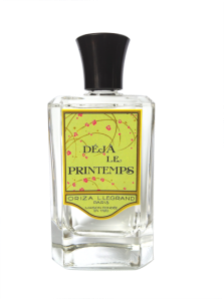 Oriza L. Legrand describes this fragrance as the essence of Spring:
Oriza L. Legrand describes this fragrance as the essence of Spring:
A promenade in the woods awakening from a long winter sleep. Morning dew is glistening like beads on wild grasses which exude fresh flavor. The sun rises and its rays awaken wet flowers and the fragrant leaves of fig trees swaying by wind. Tree buds swollen with young leaves, flower buds ready to bloom, and the earth, with its smell of turf and twisted roots, full of vitality. The first lilies of the valley reveal themselves. It’s spring awakening. Spring has come.
Fragrance notes: Top notes: Mint, Orange Blossom, Chamomile. Middle notes: Fig Leaves, Clover, Mown Grass, Lily of the Valley, Galbanum. Base notes: Musk, Vetiver, Cedar, Moss.
Call me crazy, but the opening of Deja Le Printemps smells like Serge Lutens‘ Iris Silver Mist to me. My notes are littered with “ISM??!!” notations, especially with regard to the first five minutes. On me, Deja Le Printemps exploded with a sharp, icy, alcohol-like blast that was just like frozen vodka, and just like that of the Lutens fragrance with its huge amounts of futuristic iris nitrile. That sharp, metallic, cold note is soon followed by sharp, pungent greenness from the galbanum, then by an oddly dewy, wet floral that must be the muguet or lily-of-the-valley. Greenness fills the base, with plushly soft oakmoss and the feeling of green sprouts pushing through the snow with Spring’s arrival. Flitting all about is a floral powder with a tinge of soapiness, and the slightest whisper of a pale, watery rose.
Despite the spring bouquet, there continues to be something that makes me think of iris. For whatever reason, Deja Le Printemps on my skin produced a very cold, rooty, almost carroty iris aroma, complete with its earthy, damp, icy feel and its touch of floral powder. I can’t account for it, and surely it’s the effect of the other accords, but I’m telling you…. Iris Silver Mist! That is only a part of Deja Le Printemps, however, as the pungent galbanum, delicate white florals, powder and green notes are equally significant.

Rex Preston, “Spring flowers, Bramley Wood” at redraggallery.co.uk
At its heart, Deja Le Printemps is very much a Spring bouquet mixed with floral powder, and quite true to its description. Alas, it had low sillage on me, and poor longevity, clocking in just shy of 5 hours. In its final moments, it was nothing more than an abstract floral blur. I am not a huge fan of either green florals or many of the notes in Deja Le Printemps, particularly galbanum and iris, so I’m afraid I wasn’t enamoured by the scent. I’m not the target audience, however, and the fragrance is well-done as a whole. It’s also the Oriza L. Legrand scent that a famous fashion icon fell in love with and bought for herself, so clearly it’s something that appeals to those with sophisticated tastes who enjoy green florals.

English countryside. Source: Pinterest.
That conclusion is supported by the lone two reviews on Fragrantica. The first raves about the “retro” delicacy of the green florals, and how Deja Le Printemps is “the best Naturalist ‘pure green'” perfume, epitomizing a walk in the countryside between Spring showers. The second review is even more positive:
This got my attention immediately! Probably because I’m in a phase of my life when I really enjoy green scents, and I love Nature. […] I fell in love with it after the first sniff. 🙂
The opening is very green and very fresh. I can smell grass, (fig) leaves, and clover. I don’t get much of mint. And I get no lily of the valley at all, but I really don’t mind. It’s probably somewhere there with the orange blossom making sure this green scent isn’t too green or sharp. But it doesn’t smell flowery or sweet at all. […]
This perfume is indeed like a walk through the countryside that’s awakening after a long winter. It’s very green, almost herbal, slightly woody, and actually quite subtle, yet very powerful. I adore it.
The fig note was much more prominent for the lone Parfumo review, as were the vetiver and a eucalyptus-like mint. “Drseid” writes:
Deja Le Printemps opens with what best can be described as a slightly aromatic eucalyptus-like mint and fig tandem with a fresh green grass undertone. As the fragrance enters the early heart the mint slowly fades, leaving the fig to directly mesh with the remaining green grass supported by resinous musky woody galbanum. As the composition progresses to the late dry-down a slightly sharp vetiver driven natural woody accord joins the remnants of the greens with a very faint tree moss undertone from the base adding weight to the relatively airy composition. Projection is on the low side of average, with average longevity at 6-8 hours on skin.
Deja Le Printemps did not exactly wow me when I first sprayed it on, but its eucalyptus-like fig and mint really does gain appeal as it gradually couples with the green grass and galbanum in the heart. That aside, it is the late dry-down with its welcome addition of vetiver and woods, however, that turns the composition into something special as they combine extremely well with the remaining greens and the aromatic fig. This whole effect indeed conjures visions of a spring countryside with fig trees in the background, green grassy fields and wild aromatic herbs growing within. The bottom line is the 120 euro per 100ml bottle Deja Le Printemps delivers what its name promises, earning a “very good” 3.5 stars out of 5 and a solid recommendation especially to lovers of fragrances like Eau de Campagne by Sisley.
If you like green florals, then I think you’ll very much enjoy Deja Le Printemps. It’s not my personal style, but I can see the finesse and elegance. It’s a fresh, sophisticated scent that succeeds in its goal of encapsulating the essence of Spring.
PRACTICAL DETAILS:
Cost & Availability: All Oriza L. Legrand fragrances are eau de parfums with about 18% concentration. They come in a single size, 100 ml or 3.4 oz, and cost €120. You can buy them directly from Oriza’s e-Store that also offers perfume samples. All 7 fragrances in the range are offered in 2 ml spray vials for €9. Shipping is listed as €9 extra, but a friend said he was charged only €7. Oriza L. Legrand ships globally, as I’ve had readers order the sample set from all over. Other vendors in Europe: Oriza L. Legrand’s perfumes are also sold at Marie-Antoinette (which was my favorite perfume shop in Paris), as well as one store in Sweden and one in the Netherlands. For details on the Swedish store, you can check Oriza L. Legrand Points of Sale page. The Netherlands retailer is Parfumaria.
